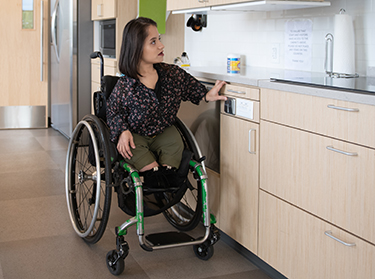While the COVID-19 pandemic had far-reaching effects on most of us, individuals with disabilities faced some unique challenges, from access to vaccinations to changes in mental health.
JoAnn Thierry, with the Centers for Disease Control and Prevention, discussed the role centers for independent living had during the pandemic. CILs are disability-led, community-based organizations that provide services to individuals with disabilities to achieve independent living. The presentation was part of the Tuesday APHA session “Emerging Public Health Issues Affecting People with Disabilities.”
 The CDC Foundation partnered with 40 CILs across the nation to identify barriers to vaccination that people with disabilities faced. CDC included individuals with disabilities in the decisionmaking process, with accessibility being the top priority. The most common barriers preventing people with disabilities from getting vaccinated were lack of accessible transportation, lack of accessible facilities, vaccine misinformation and lack of communication.
The CDC Foundation partnered with 40 CILs across the nation to identify barriers to vaccination that people with disabilities faced. CDC included individuals with disabilities in the decisionmaking process, with accessibility being the top priority. The most common barriers preventing people with disabilities from getting vaccinated were lack of accessible transportation, lack of accessible facilities, vaccine misinformation and lack of communication.
With the CDC’s funding, the CILs were able to provide vaccine information, identify people who were unable to travel to be vaccinated, help people who had difficulty scheduling vaccination appointments and arrange in-home vaccinations.
According to Thierry, CILs could have had an even bigger positive impact on vaccinations, but “most state and local health departments didn’t understand CILs…what they are or that they are even there.”Between November 2021 and December 2022, CIL staff served 22,565 consumers and reached approximately 2.95 million people through communication and outreach efforts. CIL staff scheduled 2,659 vaccination appointments; arranged 2,563 in-home vaccinations; and coordinated 766 accessible transportation appointments.
“What we really learned from this is that CILs are an underutilized resource,” Thierry said.
The impact of the pandemic on Korean families
Esther Son, an associate professor with the City University of New York’s department of social work, studied the impact COVID-19 had on Korean families with children and young adults with developmental disabilities.
Sampling methods were used to recruit 30 Korean immigrant families with children or young adults with developmental disabilities and 23 Korean immigrant families who had children without developmental disabilities.
Son’s research found that the pandemic had a greater effect on the mental health of children and young adults with developmental disabilities than those without developmental disabilities. The percentages of children and young adults with developmental disabilities with anxiety, depression, and emotional and behavioral symptoms increased significantly from before the pandemic to after. Within this study group, rates of anxiety rose from 17% before the pandemic to 23%, depression increased from 27% to 63%, and emotional and behavioral symptoms increased from 27% to 33%.
In addition, anxiety rates among parents and others caring for children or young adults with developmental disabilities were higher than those of the parents and caregivers of children or young adults without developmental disabilities.
The primary concerns for parents and caregivers also differed between the group with developmental disabilities and group without. Top concerns during the COVID-19 pandemic among Korean immigrant families of children with developmental disabilities were loneliness and isolation from their child’s family and friends, managing the unstructured time of child, their child’s physical health and management of their child’s medical treatment.
Photo: A South Asian person sits in her wheelchair and presses a button to lower the height-adjustable shelves in an accessible kitchen. Photo by Chona Kasinger, courtesy Disabled and Here, via Creative Commons.